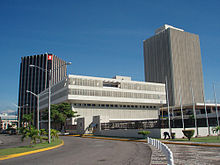
Back اقتصاد جامايكا Arabic Economía de Xamaica AST Economia de Jamaica Catalan Ekonomika Jamajky Czech Economía de Jamaica Spanish Économie de la Jamaïque French Economía de Xamaica Galician Ճամայկայի տնտեսություն Armenian Ekonomio di Jamaika IO Ikanami a Jumieka JAM
 | |
| Currency | Jamaican dollar (JMD, J$) |
|---|---|
Trade organisations | CARICOM , WTO |
Country group |
|
| Statistics | |
| Population | |
| GDP | |
| GDP rank | |
GDP growth |
|
GDP per capita | |
GDP per capita rank | |
GDP by sector |
|
| 3.733% (2018)[4] | |
Population below poverty line | |
Labour force | |
| Unemployment | |
Average gross salary | J$272,604 (£1,493/$2,498)[13] |
| J$255,021 (£1,396/$2,337) | |
Main industries | tourism, bauxite/alumina, food processing, light manufactures, rum, cement, metal, paper, chemical products, telecommunications |
| External | |
| Exports | |
Export goods | alumina, bauxite, chemicals, coffee, mineral fuels, waste and scrap metals, sugar, yams |
Main export partners |
|
| Imports | |
Import goods | food and other consumer goods, industrial supplies, fuel, parts and accessories of capital goods, machinery and transport equipment, construction materials |
Main import partners |
|
FDI stock | |
Gross external debt | |
| Public finances | |
| +0.5% (of GDP) (2017 est.)[6] | |
| Revenues | 4.382 billion (2017 est.)[6] |
| Expenses | 4.314 billion (2017 est.)[6] |
| Economic aid | recipient: $102.7 million (1995) |
All values, unless otherwise stated, are in US dollars. | |
The economy of Jamaica is heavily reliant on services, accounting for 71% of the country's GDP.[16] Jamaica has natural resources and a climate conducive to agriculture and tourism. The discovery of bauxite in the 1940s and the subsequent establishment of the bauxite-alumina industry shifted Jamaica's economy from sugar, and bananas.[17]
Weakness in the financial sector, speculation, and lower levels of investment erode confidence in the productive sector. The government continues its efforts to raise new sovereign debt in local and international financial markets in order to meet its U.S. dollar debt obligations, to mop up liquidity to maintain the exchange rate and to help fund the current budget deficit.
The Jamaican government's economic policies encourage foreign investment in areas that earn or save foreign exchange, generate employment, and use local raw materials. The government also provides a wide range of incentives to investors.
Free trade zones have stimulated investment in garment assembly, light manufacturing, and data entry by foreign firms. However, over the last 5 years[when?], the garment industry has suffered from reduced export earnings, continued factory closures, and rising unemployment. The Government of Jamaica hopes to encourage economic activity through a combination of privatization, financial sector restructuring, reduced interest rates, and by boosting tourism and related productive activities.
- ^ "World Economic Outlook Database, April 2019". International Monetary Fund. Archived from the original on 10 October 2020. Retrieved 29 September 2019.
- ^ "World Bank Country and Lending Groups". datahelpdesk.worldbank.org. World Bank. Archived from the original on 28 October 2019. Retrieved 29 September 2019.
- ^ "Population Statistics". statinja.gov.jm. Statistical Institute of Jamaica. Archived from the original on 28 March 2017. Retrieved 3 December 2019.
- ^ a b c d e f "World Economic Outlook Database, October 2024". International Monetary Fund. Retrieved 24 January 2025.
- ^ "Jamaica GDP - composition by sector". IndexMundi. Archived from the original on 28 March 2018. Retrieved 27 March 2018.
- ^ a b c d e f g h i j k l m n o "The World Factbook". CIA.gov. Central Intelligence Agency. Archived from the original on 11 January 2021. Retrieved 3 December 2019.
- ^ "Poverty headcount ratio at $5.50 a day (2011 PPP) (% of population) - Jamaica". data.worldbank.org. World Bank. Archived from the original on 3 December 2019. Retrieved 3 December 2019.
- ^ "Human Development Index (HDI)". hdr.undp.org. HDRO (Human Development Report Office) United Nations Development Programme. Archived from the original on 19 March 2022. Retrieved 17 November 2022.
- ^ "Inequality-adjusted Human Development Index (IHDI)". hdr.undp.org. HDRO (Human Development Report Office) United Nations Development Programme. Archived from the original on 12 December 2020. Retrieved 17 November 2022.
- ^ "Labor force, total - Jamaica". data.worldbank.org. World Bank. Retrieved 3 December 2019.
- ^ "Employment to population ratio, 15+, total (%) (National estimate) - Jamaica | Data". data.worldbank.org. World Bank. Archived from the original on 3 December 2019. Retrieved 3 December 2019.
- ^ "Labour Force Survey July 2019". statinja.gov.jm. Statistical Institute of Jamaica. Archived from the original on 20 August 2018. Retrieved 3 December 2019.
- ^ "Salary Survey in Jamaica". Archived from the original on 14 June 2015. Retrieved 11 June 2015.
- ^ "Sovereigns rating list". Standard & Poor's. Archived from the original on 28 September 2011. Retrieved 26 May 2011.
- ^ a b c Rogers, Simon; Sedghi, Ami (15 April 2011). "How Fitch, Moody's and S&P rate each country's credit rating". The Guardian. Archived from the original on 1 August 2013. Retrieved 31 May 2011.
- ^ "CENTRAL AMERICA AND CARIBBEAN :: JAMAICA". The World Factbook. Central Intelligence Agency. Archived from the original on 11 January 2021. Retrieved 30 November 2017.
- ^ "Jamaica (04/01)". Archived from the original on 4 October 2015. Retrieved 11 June 2015.